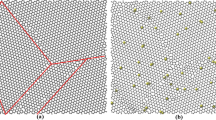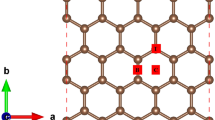Abstract
The adsorption of molecular hydrogen on the monolayer graphene sheet under varied temperature and pressure was studied using molecular dynamics simulations (MDS). A novel method for obtaining potential energy distributions (PEDs) of systems was developed to estimate the gravimetric density or weight percentage of hydrogen. The Tersoff and Lennard–Jones (LJ) potentials were used to describe interatomic interactions of carbon–carbon atoms in the graphene sheet and the interactions between graphene and hydrogen molecules, respectively. The results estimated by the use of novel method in conjunction with MDS developed herein were found to be in excellent agreement with the existing experimental results. The effect of pressure and temperature was studied on the adsorption energy and gravimetric density for hydrogen storage. In particular, we focused on hydrogen adsorption on graphene layer considering the respective low temperature and pressure in the range of 77–300 K and 1–10 MPa for gas storage purpose which indicate the combination of optimal extreme conditions. Adsorption isotherms were plotted at 77 K, 100 K, 200 K, and 300 K temperatures and up to 10 MPa pressure. The simulation results indicate that the reduction in temperature and increase in pressure favor the gravimetric density and adsorption energies. At 77 K and 10 MPa, the maximum gravimetric density of 6.71% was observed. Adsorption isotherms were also analyzed using Langmuir, Freundlich, Sips, Toth, and Fritz–Schlunder equations. Error analysis was performed for the determination of isotherm parameters using the sum of the squares of errors (SSE), the hybrid fractional error function (HYBRID), the average relative error (ARE), the Marquardt’s percent standard deviation (MPSD), and the sum of the absolute errors (SAE).





Similar content being viewed by others
References
Kumar KV, Salih A, Lu L, Müller EA, Rodríguez-Reinoso F (2012) Molecular simulation of hydrogen physisorption and chemisorption in nanoporous carbon structures. Adsorpt Sci Technol 29(8):799–817. https://doi.org/10.1260/0263-6174.29.8.799
Stalker MR, Grant J, Yong CW, Ohene-Yeboah LA, Mays TJ, Parker SC (2019) Molecular simulation of hydrogen storage and transport in cellulose. Mol Simul. https://doi.org/10.1080/08927022.2019.1593975
Chang EC (2017) Robust and optimal technical method with application to hydrogen fuel cell systems. Int J Hydrog Energy 42(40):25326–25333. https://doi.org/10.1016/j.ijhydene.2017.08.119
Barrett S (2005) Progress in the European hydrogen and fuel cell technology platform. Fuel Cells Bull 2005(4):12–17. https://doi.org/10.1016/S1464-2859(05)00591-2
Houf WG, Evans GH, Ekoto IW, Merilo EG, Groethe MA (2013) Hydrogen fuel-cell forklift vehicle releases in enclosed spaces. Int J Hydrog Energy 38(19):8179–8189. https://doi.org/10.1016/j.ijhydene.2012.05.115
Rivard E, Trudeau M, Zaghib K (2019) Hydrogen storage for mobility: a review. Materials. https://doi.org/10.3390/ma12121973
Moradi R, Groth KM (2019) Hydrogen storage and delivery: review of the state of the art technologies and risk and reliability analysis. Int J Hydrog Energy 44(23):12254–12269. https://doi.org/10.1016/j.ijhydene.2019.03.041
Barthélémy H (2012) Hydrogen storage: industrial prospectives. Int J Hydrog Energy. https://doi.org/10.1016/j.ijhydene.2012.04.121
Barthelemy H, Weber M, Barbier F (2017) Hydrogen storage: recent improvements and industrial perspectives. Int J Hydrog Energy. https://doi.org/10.1016/j.ijhydene.2016.03.178
Weinberger B, Lamari FD (2009) High pressure cryo-storage of hydrogen by adsorption at 77 K and up to 50 MPa. Int J Hydrog Energy 34(7):3058–3064. https://doi.org/10.1016/j.ijhydene.2009.01.093
Barghi SH, Tsotsis TT, Sahimi M (2014) Chemisorption, physisorption and hysteresis during hydrogen storage in carbon nanotubes. Int J Hydrog Energy 39(3):1390–1397. https://doi.org/10.1016/j.ijhydene.2013.10.163
Bastos-Neto M, Patzschke C, Lange M, Möllmer J, Möller A, Fichtner S, Schrage C, Lässig D, Lincke J, Staudt R et al (2012) Assessment of hydrogen storage by physisorption in porous materials. Energy Environ Sci 5(8):8294–8303. https://doi.org/10.1039/c2ee22037g
Hydrogen Storage Department of Energy (2020). https://www.energy.gov/eere/fuelcells/hydrogen-storage. Accessed 15 Jul 2020
Novoselov KS, Geim AK, Morozov SV, Jiang D, Zhang Y, Dubonos SV, Grigorieva IV, Firsov AA (2004) Electric field in atomically thin carbon films. Science. https://doi.org/10.1126/science.1102896
Lee C, Wei X, Kysar JW, Hone J (2008) Measurement of the elastic properties and intrinsic strength of monolayer graphene. Science 321(5887):385–388. https://doi.org/10.1126/science.1157996
Alian AR, Meguid SA, Kundalwal SI (2017) Unraveling the influence of grain boundaries on the mechanical properties of polycrystalline carbon nanotubes. Carbon 125:180–188. https://doi.org/10.1016/j.carbon.2017.09.056
Balandin AA, Ghosh S, Bao W, Calizo I, Teweldebrhan D, Miao F, Lau CN (2008) Superior thermal conductivity of single-layer graphene. Nano Lett. https://doi.org/10.1021/nl0731872
Zhu Y, Murali S, Cai W, Li X, Suk JW, Potts JR, Ruoff RS (2010) Graphene and graphene oxide: synthesis, properties, and applications. Adv Mater 22(35):3906–3924. https://doi.org/10.1002/adma.201001068
Patchkovskii S, Tse JS, Yurchenko SN, Zhechkov L, Heine T, Seifert G (2005) Graphene nanostructures as tunable storage media for molecular hydrogen. Proc Natl Acad Sci USA 102(30):10439–10444. https://doi.org/10.1073/pnas.0501030102
Kumar A, Sharma K, Dixit AR (2020) A review on the mechanical properties of polymer composites reinforced by carbon nanotubes and graphene. Carbon Lett. https://doi.org/10.1007/s42823-020-00161-x
Cui Y, Kundalwal SI, Kumar S (2016) Gas barrier performance of graphene / polymer nanocomposites. Carbon 98:313–333. https://doi.org/10.1016/j.carbon.2015.11.018
Kundalwal SI, Meguid SA, Weng GJ (2017) Strain gradient polarization in graphene. Carbon 117:462–472. https://doi.org/10.1016/J.CARBON.2017.03.013
Klechikov AG, Mercier G, Merino P, Blanco S, Merino C, Talyzin AV (2015) Hydrogen storage in bulk graphene-related materials. Microporous Mesoporous Mater 210:46–51. https://doi.org/10.1016/j.micromeso.2015.02.017
Ma LP, Wu ZS, Li J, Wu ED, Ren WC, Cheng HM (2009) Hydrogen adsorption behavior of graphene above critical temperature. Int J Hydrog Energy 34(5):2329–2332. https://doi.org/10.1016/j.ijhydene.2008.12.079
Prabhu SA, Kavithayeni V, Suganthy R, Geetha K (2020) Graphene quantum dots synthesis and energy application: a review. Carbon Lett. https://doi.org/10.1007/s42823-020-00154-w
Shiraz HG, Tavakoli O (2017) Investigation of graphene-based systems for hydrogen storage. Renew Sustain Energy Rev 74:104–109. https://doi.org/10.1016/j.rser.2017.02.052
Pyle DS, Gray EMA, Webb CJ (2016) Hydrogen storage in carbon nanostructures via spillover. Int J Hydrog Energy 41(42):19098–19113. https://doi.org/10.1016/j.ijhydene.2016.08.061
Jain V, Kandasubramanian B (2020) Functionalized graphene materials for hydrogen storage. J Mater Sci 55(5):1865–1903. https://doi.org/10.1007/s10853-019-04150-y
Shevlin SA, Guo ZX (2007) Hydrogen sorption in defective hexagonal BN sheets and BN nanotubes. Phys Rev B. https://doi.org/10.1103/PhysRevB.76.024104
Mohan M, Sharma VK, Kumar EA, Gayathri V (2019) Hydrogen storage in carbon materials: a review. Energy Storage 1(2):e35. https://doi.org/10.1002/est2.35
Nagar R, Vinayan BP, Samantaray SS, Ramaprabhu S (2017) Recent advances in hydrogen storage using catalytically and chemically modified graphene nanocomposites. J Mater Chem A 5(44):22897–22912. https://doi.org/10.1039/c7ta05068b
Wang Q, Johnson JK (1999) Computer simulations of hydrogen adsorption on graphite nanofibers. J Phys Chem B 103(2):279–281. https://doi.org/10.1021/jp9839100
Chambers A, Park C, Baker RTK, Rodriguez NM (1998) Hydrogen storage in graphite nanofibers. J Phys Chem B. https://doi.org/10.1021/jp980114l
Jhi SH (2007) A theoretical study of activated nanostructured materials for hydrogen storage. Catal Today 120:383–388. https://doi.org/10.1016/j.cattod.2006.09.025
Figueroa-Torres MZ, Robau-Sánchez A, la Torre-Sáenz L, Aguilae-Elguezabal A (2007) Hydrogen adsorption by nanostructured carbons synthesized by chemical activation. Microporous Mesoporous Mater 98(1–3):89–93. https://doi.org/10.1016/j.micromeso.2006.08.022
López-Corral I, Germán E, Volpe MA, Brizuela GP, Juan A (2010) Tight-binding study of hydrogen adsorption on palladium decorated graphene and carbon nanotubes. Int J Hydrog Energy 35(6):2377–2384. https://doi.org/10.1016/j.ijhydene.2009.12.155
Huang CC, Pu NW, Wang CA, Huang JC, Sung Y, Der GM (2011) Hydrogen storage in graphene decorated with Pd and Pt nano-particles using an electroless deposition technique. Sep Purif Technol 82(1):210–215. https://doi.org/10.1016/j.seppur.2011.09.020
Petrushenko IK, Petrushenko KB (2018) Hydrogen adsorption on graphene, hexagonal boron nitride, and graphene-like boron nitride-carbon heterostructures: a comparative theoretical study. Int J Hydrog Energy 43(2):801–808. https://doi.org/10.1016/j.ijhydene.2017.11.088
Feng Y, Wang J, Liu Y, Zheng Q (2019) Adsorption equilibrium of hydrogen adsorption on activated carbon, multi-walled carbon nanotubes and graphene sheets. Cryogenics 101:36–42. https://doi.org/10.1016/j.cryogenics.2019.05.009
Plimpton S (1995) Fast parallel algorithms for short-range molecular dynamics. J Comput Phys 117(1):1–19. https://doi.org/10.1006/jcph.1995.1039
Momma K, Izumi F (2011) VESTA 3 for three-dimensional visualization of crystal, volumetric and morphology data. J Appl Crystallogr 44(6):1272–1276. https://doi.org/10.1107/S0021889811038970
Tersoff J (1989) Modeling solid-state chemistry: Interatomic potentials for multicomponent systems. Phys Rev B 39(8):5566–5568. https://doi.org/10.1103/PhysRevB.39.5566
Javvaji B, Budarapu PR, Sutrakar VK, Mahapatra DR, Paggi M, Zi G, Rabczuk T (2016) Mechanical properties of Graphene: Molecular dynamics simulations correlated to continuum based scaling laws. Comput Mater Sci 125:319–327. https://doi.org/10.1016/j.commatsci.2016.08.016
Thomas S, Ajith KM (2014) Molecular dynamics simulation of the thermo-mechanical properties of monolayer graphene sheet. Proced Mater Sci 5:489–498. https://doi.org/10.1016/j.mspro.2014.07.292
Volokh KY (2012) On the strength of graphene. J Appl Mech Trans ASME. https://doi.org/10.1115/1.4005582
Bu H, Chen Y, Zou M, Yi H, Bi K, Ni Z (2009) Atomistic simulations of mechanical properties of graphene nanoribbons. Phys Lett Sect A 373(37):3359–3362. https://doi.org/10.1016/j.physleta.2009.07.048
Cracknell RF (2001) Molecular simulation of hydrogen adsorption in graphitic nanofibres. Phys Chem Chem Phys 3(11):2091–2097. https://doi.org/10.1039/b100144m
Kundalwal SI, Choyal VK, Luhadiya N, Choyal V (2020) Effect of carbon doping on electromechanical response of boron nitride nanosheets. Nanotechnology. https://doi.org/10.1088/1361-6528/ab9d43
Langmuir I (1918) The adsorption of gases on plane surfaces of glass, mica and platinum. J Am Chem Soc 40(9):1361–1403. https://doi.org/10.1021/ja02242a004
Freundlich H (1907) Über die adsorption in Lösungen. Z Phys Chem 57U(1):385–470. https://doi.org/10.1515/zpch-1907-5723
Sips R (1948) On the structure of a catalyst surface. J Chem Phys 16(5):490–495. https://doi.org/10.1063/1.1746922
Tóth J (2000) Calculation of the BET-compatible surface area from any Type I isotherms measured above the critical temperature. J Colloid Interface Sci 225(2):378–383. https://doi.org/10.1006/jcis.2000.6723
Fritz W, Schluender EU (1974) Simultaneous adsorption equilibria of organic solutes in dilute aqueous solutions on activated carbon. Chem Eng Sci 29(5):1279–1282. https://doi.org/10.1016/0009-2509(74)80128-4
Porter JF, McKay G, Choy KH (1999) The prediction of sorption from a binary mixture of acidic dyes using single- and mixed-isotherm variants of the ideal adsorbed solute theory. Chem Eng Sci 54(24):5863–5885. https://doi.org/10.1016/S0009-2509(99)00178-5
Winter C-J (2009) Hydrogen energy d Abundant, efficient, clean: a debate over the energy-system-of-change. Int J Hydrog Energy 34:S1–S52. https://doi.org/10.1016/j.ijhydene.2009.05.063
Dimitrakaki GK, Tylianakis E, Froudakis GE (2008) Pillared graphene: a new 3-D network nanostructure for enhanced hydrogen storage. Nano Lett 8(10):3166–3170. https://doi.org/10.1021/nl801417w
Lamari FD, Levesque D (2011) Hydrogen adsorption on functionalized graphene. Carbon 49(15):5196–5200. https://doi.org/10.1016/j.carbon.2011.07.036
Tien C (1994) Adsorption calculations and modelling. Butterworth-Heinemann Boston. https://doi.org/10.1016/c2009-0-26911-x
Acknowledgements
The work was supported by the Department of Science and Technology (DST), Ministry of Science and Technology, Government of India. Second and third authors acknowledge the generous support of the DST Grant (DST/TMD/HFC/2K18/88).
Author information
Authors and Affiliations
Corresponding author
Ethics declarations
Conflict of interest
On behalf of all authors, the corresponding author states that there is no conflict of interest.
Additional information
Publisher's Note
Springer Nature remains neutral with regard to jurisdictional claims in published maps and institutional affiliations.
Rights and permissions
About this article
Cite this article
Luhadiya, N., Kundalwal, S.I. & Sahu, S.K. Investigation of hydrogen adsorption behavior of graphene under varied conditions using a novel energy-centered method. Carbon Lett. 31, 655–666 (2021). https://doi.org/10.1007/s42823-021-00236-3
Received:
Revised:
Accepted:
Published:
Issue Date:
DOI: https://doi.org/10.1007/s42823-021-00236-3




